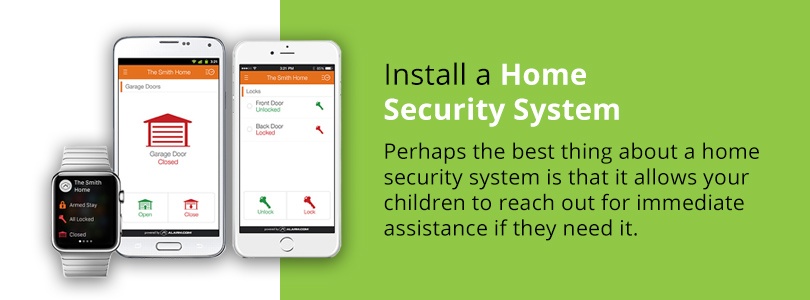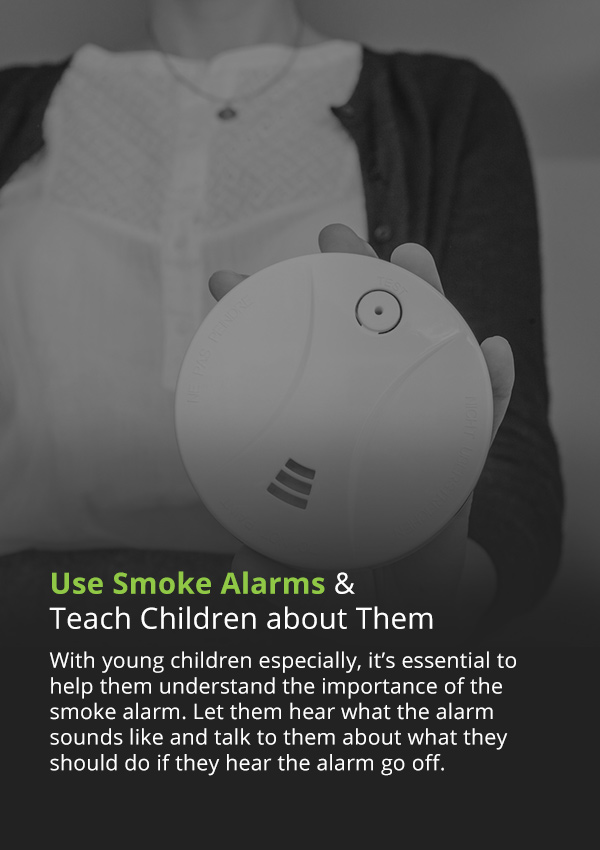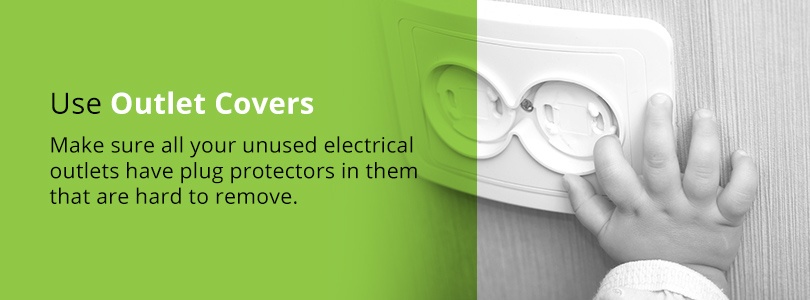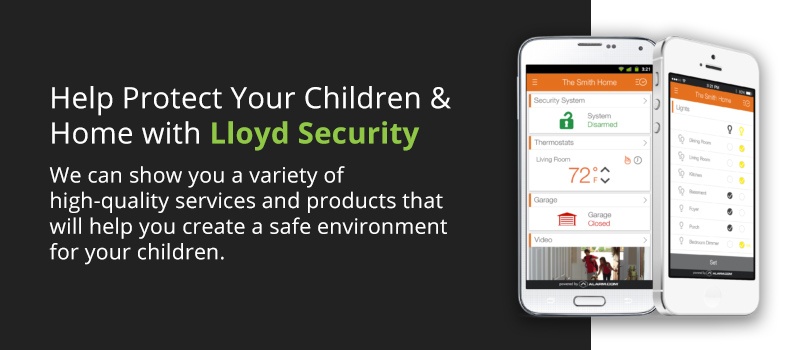
Have you noticed the recent rash of child home injuries covered by the media? Children are curious when the very young. They like to open things, put objects in their mouths, sneak into places where they shouldn’t be and play with dangerous items that they think can be used as a toy.
On the one hand, we want to encourage their curiosity because that’s the way they learn about the world. On the other hand, we need to make sure that curiosity doesn’t lead them into danger. The dangers the children face can also change quickly because children grow so fast and as they grow parents must often change or expand the way they childproof their homes.
Home safety and security are part of Lloyd Security’s mission. We know nothing is more important than the safety and security of our children. Consider implementing some of these tips and tricks to help you keep your children safe.
1. Install a Home Security System
Most people probably think that you install a home security system to prevent your home from being burglarized and to prevent intruders from entering your home. This was certainly true in the past when home security systems were much less developed than they are today and is still true today to a large extent.
Modern security systems, however, offer many new features that can help protect children and keep them safe.
For instance, some security systems allow you to prevent anyone from entering or leaving your home once that feature has been turned on. All parents understand that you need to be on constant alert when you have a young toddler, as sometimes it can only take a minute before they vanish out of sight and wander out the door. This feature means that even if you lose sight of your child for an instant, they won’t be able to open a door and wander outside into the street or towards a swimming pool in the backyard.
Another benefit of almost all new security systems is that they feature the ability to monitor what’s happening in your home via electronic devices such as a computer, a smartphone or a tablet. When your kids are older and home alone after school, you can see what they’re up to while you’re still at work and make sure they’re safe. Since these video monitoring systems are wireless, this also means that no one inside or outside the home can cut a wire to disable or disrupt the system.
A home security system will also allow you to control items like lights or thermostats when your kids are home. Most parents know that even older children are terrible at remembering to turn off the lights when not in the room or not to leave the TV running when they are no longer watching a show. A home security system can let you turn off your lights and the TV as well as control the thermostat. A security system helps you protect your children and allows you to control the way they use energy when you’re not home.

Finally, perhaps the best thing about a home security system is that it allows your children to reach out for immediate assistance if they need it. Suppose you or your spouse are at home and suffer an accident or a serious medical incident like a heart attack or stroke. A good security system has a button on its control panel that will allow your children to notify fire, police or medical authorities that there’s an emergency. Other systems will allow your children to speak with someone at a central location immediately. Either option is much faster than having a child, probably frightened by what is happening to the parent, call 911.
2. Use Safety Gates
Safety gates are particularly important to use when your children have just learned to walk and while they are toddlers. Installing baby gates at the top and the bottom of stairs helps prevent dangerous falls. Safety gates can also be used to keep young children out of rooms that contain many potential dangers such as the kitchen or the bathroom.
However, never install a pressure-mounted safety gate at the top of the stairs. Slightly older children can often push them out of place. Use a gate that is hard-mounted into the wall and the banister at the top of the stairs.
3. Lock Cabinets and Drawers Especially in the Kitchen and Bathroom
Kitchens and bathrooms contain many potential hazards for young children. Sharp objects, unsafe medicines, toxic substances like household cleaners or small items that could easily block a child’s airway are often available in cabinets and drawers.
Install safety latches on all cabinets and drawers in kitchens, bathrooms and any location you feel could be potentially dangerous. An interior latch can be more difficult to install in a place like a kitchen drawer but is safer because adults can forget to replace an external lock. If you need to use external locks, it’s vital to remember to reattach them every time you use the drawer or the cabinet.
Also, ensure any potentially dangerous chemicals are stored in higher cabinets, far out of the reach of curious young hands. Many people store household cleaners in a cabinet under the kitchen sink, so this is one area that you need to make certain is securely locked.
In 2017, poison control centers located across the United States reported that they helped parents deal with 2.12 million situations involving a child ingesting something poisonous such as a household cleaner or adult medicine. That means they are dealing with a poisoning crisis once every 14.9 seconds. So you can see why it’s so critical to make sure that you have proper safety latches on all your bathroom and kitchen drawers and cabinets.
4. Practice Gun Safety
It seems that every week, there is another story in the media about a young child finding a gun in the bedroom drawer or their mother’s purse and accidentally shooting themselves, a sibling, a friend or even a parent.
Guns are a reality in many American homes, and it’s critical that they are stored safely to protect children. If you have a young child or even a teenager, you should store your gun unloaded, locked and placed in a safe storage area. You can also use trigger locks, gun cabinets or gun safes.
Although it can be somewhat touchy, if your child is going to a friend’s house to play, it’s okay to ask the parents if they have guns and if are they stored and locked properly.
5. Use Smoke Alarms and Teach Children about Them

Smoke alarms are one of the most important things to install in your home to protect your children and yourself. With young children especially, it’s essential to help them understand the importance of the smoke alarm. Let them hear what the alarm sounds like and talk to them about what they should do if they hear the alarm go off. If a child is unfamiliar with the sound of a smoke alarm, it may frighten and confuse them instead of warning them of danger.
If you need to buy new smoke alarms, take your children with you. Explain to them how smoke alarms work. Let them help you replace the batteries every six months, but make sure you tell them never to remove the batteries once the smoke detector is active. They can also help you test the smoke alarms once a month.
Every family should have a fire escape plan, and they should practice it at least twice a year. Children should know where to go once they are outside the home if there is a fire. You can probably ask one of your neighbors if it’s okay for your children to come to their home if there is a fire.
6. Use Carbon Monoxide Alarms
Carbon monoxide (CO) is known as the silent killer because it is colorless and odorless. If inhaled over a long time, it can be deadly. A heating system or malfunctioning HVAC system can produce CO. With so many people taking extra steps to make their homes more energy efficient and sealed up tighter, this increases the risk of a carbon monoxide incident.
Install carbon monoxide detectors outside the bedrooms in your home. Take the same steps with the carbon monoxide system that you do with your smoke alarms. Make sure your children are familiar with the carbon monoxide alarms and explain their purpose and what to do if the alarm goes off.
7. Set Water Temperature
It only takes three seconds for water at a temperature of 140°F to create third-degree burns on a child. For that reason, set the water heater temperature in your home to 120°F, which is still hot enough to enjoy a good shower but not hot enough to burn a child.
You can also install anti-scalding devices on showerheads and taps to prevent burns.
8. Use Window Guards
Every year in the United States, about eight children under age 5 die from window-fall injuries. Another 3,300 visit emergency rooms for the same reason and suffer concussions, other head injuries, broken limbs or worse.
Installing window guards or gates is one of the most important things for a parent to do. A good window guard should allow you to open your window between 3 and 6 inches to allow a breeze but not any farther, so a young child can’t fall out. It must be dependable enough to prevent a child from opening them but easy for an adult open in case of a fire.
Never assume a window screen will prevent your child from falling. Screens are not strong enough to prevent a child from falling out a window if a child pushes on a screen hard enough or falls against it.
9. Use Outlet Covers
As we mentioned above, young children are curious and are fascinated by electrical outlets. They like to stick things in the outlets, like spoons, knives or forks, to see what will happen. Well, what will happen is they will get a nasty shock and maybe worse.

Make sure all your unused electrical outlets have plug protectors in them that are hard to remove. This is particularly important for any electrical outlet located near the floor. Extension strips should be placed behind furniture. If that is not possible, then purchase guards to place on top of the strips.
10. Use Bumpers on Coffee Tables and Other Furniture
Coffee tables, entertainment cabinets, storage cabinets and other pieces of furniture have sharp edges. Once young children can walk, they enjoy moving around living spaces. Falls are a regular occurrence. If your children fall on the corner of one of these sharp edges, the result can be a serious head wound.
It’s a good idea to get down on your hands and knees and crawl around the spaces in which your young children travel. It makes it much easier to spot the sharp corners that you may miss when you’re standing up straight. Make sure all the sharp corners have been outfitted with plastic edges or padding.
11. Use Anchors on Furniture
In the past, when TVs were basically constructed from tubes and wires, it was difficult for a child to pull them off of shelves or a cabinet on top of themselves. Yet they still did. It’s even easier these days with flatscreen TVs. Children also like to crawl up cabinets or dressers, which can easily tumble over on top of them.
Look around your home and see what pieces of furniture pose this kind of danger. You can buy furniture tethers at your local home improvement store. Anchoring your furniture is critical. Don’t think, “Oh, it can’t happen here,” because it can.
12. Shut and Even Lock the Lid on Your Toilet
Drowning is the second leading cause of death among young children after car crashes and the leading cause for children aged 1 to 4. Children can drown in only 1 inch of water. Young children are fascinated by toilets and the way they work. You might think that your child could never fall in the toilet, but when they’re young, they are more top-heavy than they are later in life, so they can fall in relatively easily.
Buy a toilet lock for all of the toilets in your home. A lock will prevent your children from falling in and keep them from putting important objects in the toilet, like your smartphone or keys.
13. Store Small Objects out of Reach
Young children like to put things in their mouth. It’s part of their experimentation with the world around them. The problem is that many of these things can cause them to choke. Small pieces of broken toys, batteries, coins, erasers, pills and small items kept in the bathroom or kitchen drawers are all potentially dangerous hazards.
If a toy, even a beloved toy, is broken, throw it away. Pay attention to the warnings that companies place on toys about the appropriate age for children to play with them. As we noted above, make sure there are appropriate locks on all drawers and cabinets in your home. It’s always a good idea to do a “sweep” once or twice a day just to make sure that no small objects have been left lying around that your child could easily pop into their mouth.
Contact Lloyd Security for Complete Home Security System to Help Protect Your Children

If you live in the Minneapolis area and you want to find a home security system that will prevent burglary and theft and protect your children, contact Lloyd Security today. We pride ourselves on being one of the most knowledgeable and well-regarded security companies in the area. We can show you a variety of high-quality services and products that will help you create a safe environment for your children.
We can give you a customized solution designed to fulfill your specific requirements. If you would like to talk to us about a home security system, you can reach us at 612-874-9295 or visit our contact us page, where you can leave us some details about your security needs. A member of our team will get back to you as soon as possible.
